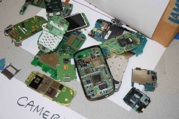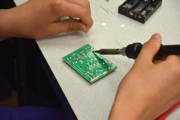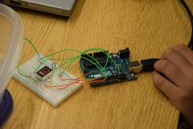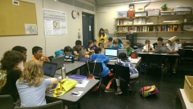The Life and Times of a Cell Phone

Why we do it?
-
•Share
-
•Educate
-
•Inspire
What is it?
A one week, full-day summer camp offered on the UW Campus from July 20 to July 24, 2015
Meets: M-F, 8 a.m.-5 p.m.
Location: UW Seattle campus
Length: One week
Registration Page: here
Lecture Notes & Resources:
Introduction to Cell Phones: here
Photolithography: here
The Story of Electronics: here
Electronic Waste: here
Electronics Lab Activities:
Cell Phone Dissection: here
Photolithography: coming soon
MicroControllers: coming soon
Wireless Comm: here
Electronic Waste Quiz: here
What does it look like?





Day 1 (Monday, July 20)

On the first day of our program, students disassemble cell phones which have been thrown away and are ready for recycling. We’ll learn about the major components of cell phones and what they do including the antenna, analog-to-digital conversion, speaker, microphone, camera, accelerometer, and a variety of other components. In the afternoon, we take cell phone parts that we select and craft them into an individual message about cell phone technology onto a visual display (craft wood).
Day 1-2 (Monday, July 20 & Tuesday, July 21)
Electronics Manufacturing: Photolithography
At the end of our first day of the program, students will design a pattern that will be masked and etched onto a real printed circuit board. On Tuesday, students will expose the design, develop, etch, and strip it to create a circuit or other more artistic creation on an etched, printed circuit board substrate. This process, called photolithography, is very similar to the process used to make integrated circuits at the micro or nano scale!
Day 2 (Tuesday, July 21)
Electronics Assembly: Soldering

Day 2/3 (Tuesday, July 21 & Wednesday, July 22)
We explore the invisible effects of cell phone and other media use by taking simple multi-tasking and reaction time tests to understand how using cell phones (and other electronic devices) change our brains and abilities.
Day 3 (Wednesday, July 22)
Building and Controlling Circuits

On Wednesday, we learn how to build simple circuits using a breadboard and control those circuits using a simple micro-controller based on the Arduino UNO package of sensors, controls, and interfaces.
Day 4 (Thursday, July 23)
Function, Control, and Sensing

Students continue with controlling a micro-controller to perform simple functions that interact with LED lights, buzzers, and other devices. The world of sensors hidden inside the cell phone also unfolds with an intriguing Mystery Sensor activity.
Day 5 (Friday, July 24)
Into the Grave we Go

University of Washington | College of Engineering | Electrical Engineering
Contact us:
Professor Denise Wilson
Department of Electrical Engineering
University of Washington
Seattle, Washington 98195-2500
206-221-5238; denisew (at) uw.edu
Link to Photographs from 2015 Workshop: click here!
Electronics Technology:
Have you ever wondered where a cell phone comes from? Where it goes when it dies? What happens in between? Join us as we look into the life and times of a typical smart phone. We'll follow our phone from conception where raw materials are collected to manufacture it, to the very end, where the corpse is dismantled, recycled, and buried. We will look at how the smart phone works at the peak of its lifespan when it is responsible for transmitting dozens of important conversations and hundreds of texts every day. Students will be introduced to the chemistry of leaching, soldering technique, signal modulation science, and touchscreen technology. No previous experience required – just interest and enthusiasm.

